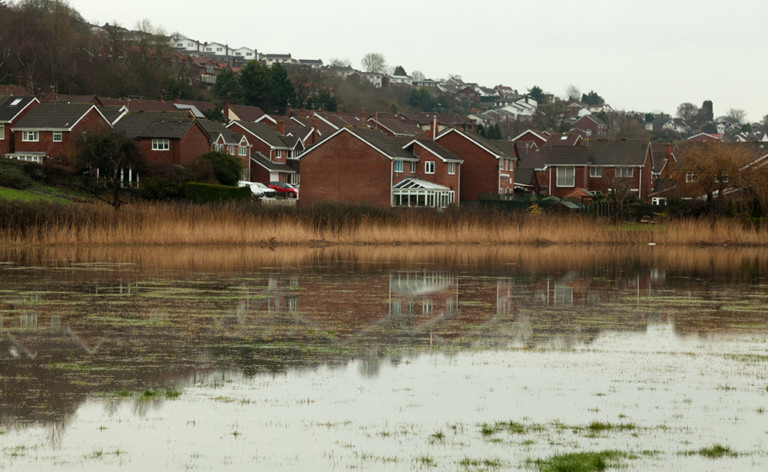New homes in UK’s struggling neighbourhoods disproportionately affected by increase in flood risk from climate change

Climate change induced increases in flood-prone new homes built in England and Wales over the last decade could be 10 to 13 times higher in struggling neighbourhoods compared to more affluent ones, according to a new report published today (3rd November) by the Grantham Research Institute on Climate Change and the Environment at the London School of Economics and Political Science.
The report finds that new homes built in economically declining and struggling parts of England and Wales between 2008 and 2018 are more likely, compared with new housing in more affluent areas, to become exposed to high flood risk over their lifetime as a result of climate change. The study includes changes in flood risk from rivers as well as from surface water and coastal flooding as a result of climate change induced changes in rainfall patterns and rising sea levels.
The report identifies those areas with the highest number of new homes at risk of flooding as London’s Thames Valley, Liverpool, Hull, Bristol and smaller areas along rivers in the East Midlands and Yorkshire and the Humber. New hot spots are also expected to emerge without further intervention, especially along lower-lying coastal areas in South East England, along the Thames in London and along the Ouse in Yorkshire and the Humber.
“Losses from flooding remain high in England and Wales despite improvements in the management of flood risk and the introduction of new regulations. There is no evidence that new homes are being built in a more flood resilient way, despite the evidence showing that the UK’s climate is becoming wetter. This has implications for future spending on flood defences and highlights issues of affordability of private level flood protection as well as flood insurance in the face of climate change.”
“The spatial shift in flood risk areas as a result of climate change is expected to disproportionately impact homes in declining or struggling areas. What might appear as an attractive option to meet housing demand and stimulate the local economy right now is likely to increase inequality, with those who can afford to moving away from high risk areas, leaving those least able to cope exposed,” said Dr. Swenja Surminski, Head of Research Adaption at the Grantham Research Institute on Climate Change and the Environment.
The report acknowledges that while there have been significant improvements in understanding of flood risk trends in England and Wales, there is still a lack of understanding of how changes to the building stock through new developments will be exposed to flooding in the long term. The report finds that local councils who make planning decisions often do not have the resources to scrutinise flood assessments conducted by developers or to check if any imposed requirements to make buildings more resilient have been implemented.
“To determine the level of risk requires a better understanding of changes and trends in different flood hazards, factors such as location, design and building characteristics that influence current and future exposure levels, and drivers of vulnerability including deprivation levels and government policy.”
“Our analysis shows that without further action the share of homes built between 2008 and 2018 that will be at high risk by the 2050s is expected to increase from five percent to eight percent under a 2°C warming scenario and could almost triple to 14% under a high-end warming scenario,” said Dr. Viktor Roezer, Research Officer at the Grantham Research Institute on Climate Change and the Environment.
Annual building rates of new homes in flood-risk areas in England and Wales have increased only moderately when looking at the national average. However, the report shows that significant differences between and within regions as well as between different flood types exist.
When considering today’s flood hazards the report finds that 5% of all buildings built between 2008 and 2018 are located in high-to medium flood risk zones, with a 1% or higher annual chance of flooding from rivers and from extreme rainfall events and a 0.5% or higher annual chance of flooding from sea.
The report also looked at the implications of new build for flood insurance, which is currently the key financial protection for homeowners. Under the current Flood Re subsidy scheme new homes build after 2009 are not guaranteed affordable insurance based on the expectation that new buildings should not be at high risk. The report warns that flood insurance could become unaffordable or unavailable in struggling areas.
Read the research report “New build homes, flood resilience and environmental justice – current and future trends under climate change across England and Wales”.
– END –
For further information and for interview requests please contact Niamh Brannigan at n.brannigan@lse.ac.uk or call +254 717733348
Notes for editors
About The Grantham Research Institute on Climate Change and the Environment
Established in 2008 at the London School of Economics and Political Science, the Institute brings together international expertise on economics, as well as finance, geography, the environment, international development and political economy to establish a world-leading centre for policy-relevant research, teaching and training in climate change and the environment. It is funded by the Grantham Foundation for the Protection of the Environment. www.lse.ac.uk/grantham/
About The Centre for Climate Change Economics and Policy (CCCEP)
The Centre for Climate Change Economics and Policy (CCCEP) was established in 2008 to advance public and private action on climate change through rigorous, innovative research. The Centre is hosted jointly by the University of Leeds and the London School of Economics and Political Science. It is funded by the UK Economic and Social Research Council. www.cccep.ac.uk

